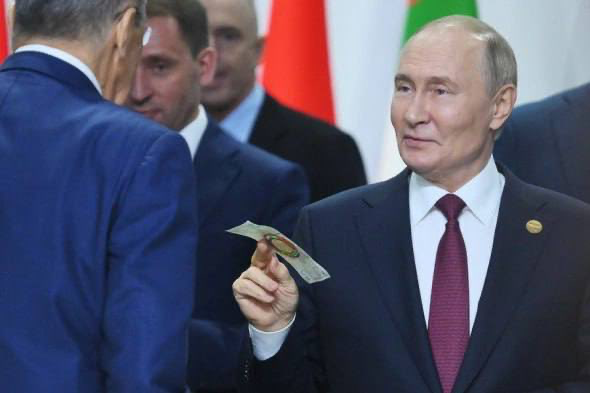At the recent BRICS summit in Kazan, Russia, leaders introduced a symbolic BRICS currency. This banknote, featuring the flags of Brazil, Russia, India, China, and South Africa, represents the group’s ambition to explore alternatives to the US dollar in global trade. BRICS is making this move as part of its growing effort to create a financial system that relies less on Western currencies and financial structures.
BRICS Preparing for a Shift in Global Finance
The BRICS nations are not rejecting the US dollar outright. Instead, they are preparing for a situation where access to the dollar could be restricted due to political measures, such as sanctions. This readiness for alternative solutions has become more urgent for countries like Russia, which has faced sanctions affecting its ability to use the global financial system. These restrictions have made it harder for Russia to access international markets dominated by the dollar. BRICS nations recognize that the US dollar remains the primary currency used in global finance.
However, the group believes that the political use of the dollar, especially in imposing sanctions, is eroding trust in the currency. This has led to efforts within BRICS to explore other ways to conduct cross-border transactions, without relying solely on the dollar.
Local Currencies in Cross-Border Payments
One of the key outcomes of the BRICS summit was the endorsement of using local currencies in cross-border payments. This marks a significant step toward reducing the dependency on the US dollar. The BRICS nations agreed that using local currencies could strengthen their economic relationships and make trade more resilient.
India played a leading role in advocating for this shift. India has already allowed trade settlements in its currency, the rupee, with countries like Russia and the UAE. This method of using local currencies allows countries to continue trading, even when access to dollars is restricted. Other BRICS nations are exploring similar measures, aiming to enhance the role of their local currencies in international transactions.
Aggressive Tariffs Fuel BRICS’ Strategic Push Toward Dollar-Free Trade
Exploring the Idea of a BRICS Currency
While the symbolic banknote has sparked discussions about a potential common BRICS currency, leaders remain cautious. There are no immediate plans to launch a shared currency among the BRICS nations. Instead, the focus is on building the financial infrastructure needed for local currency transactions.
Reports suggest that the potential name for the common currency could be “the unit,” and that it might receive backing from gold and the currencies of the BRICS nations. However, these ideas remain speculative, as no official announcements have been made about a BRICS currency. For now, the group focuses on improving the use of local currencies and ensuring smooth functioning of cross-border payments.
Building Financial Infrastructure
Another significant outcome of the summit was the decision to establish a cross-border settlement system called BRICS Clear. This system is intended to support the use of local currencies in international trade. BRICS Clear will work alongside existing financial market mechanisms and help promote local currency payments among the member nations.
The leaders of BRICS have tasked their finance ministers and central bank governors with taking steps to improve financial integration. This includes making local currency transactions easier and developing the infrastructure needed to support these payments.
Challenges in Moving Toward Financial Independence
While the endorsement of local currency use is an important step, there are challenges ahead. One of the main challenges is moving away from the current Western-dominated financial systems, which still play a significant role in global trade. Western countries designed many of the rules and platforms used in international finance, so transitioning away from them will take time and effort.
BRICS nations understand that it is not easy to break away from these established systems. They are committed to finding ways to reduce their dependence on the US dollar and other Western financial tools. This effort will involve building their own financial systems that are fairer and more aligned with the interests of the BRICS nations.
BRICS Expands Global Influence: Nigeria Joins as Ninth Partner in Powerful Bloc
BRICS Resistance to Western Economic Policies
At the summit, the BRICS nations also expressed their opposition to certain Western economic policies. One example is their rejection of the European Union’s Carbon Border Adjustment Mechanism. The BRICS group called this policy a “protectionist measure” that unfairly targets developing nations under the pretext of environmental protection.
This stance reflects the broader goal is to resist what they see as Western economic dominance. The BRICS nations believe that the current global financial system is designed to benefit Western countries at the expense of others. By developing their own financial systems, they aim to create a more equitable global economy.
Looking Ahead: A New Financial Landscape
While the idea of a common BRICS currency is still far from becoming a reality, the group’s focus on local currency settlements is a clear step toward financial independence. The symbolic banknote unveiled at the summit represents the group’s desire for change in the global financial landscape.
The grouping is enhancing its ability to trade using local currencies and building the necessary infrastructure to support these transactions. As the group continues to challenge the status quo of global finance, it remains committed to finding alternatives to dollar dominance.
The BRICS nations are not directly opposing the US dollar but are preparing for a world where they are less reliant on it. By promoting the use of local currencies and developing new financial systems. BRICS is working toward a future where its members have greater control over their economic destinies. This move is part of a broader vision for a fairer and more balanced global financial system. Where all nations have equal opportunities to participate and thrive.

